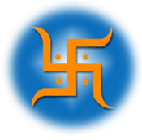The Swastika (from Sanskrit svastika) is an equilateral cross its arms bent at right angles.It occurs today in the modern day culture of India, sometimes as a geometrical motif and sometimes as a religious symbol; it remains widely used in Eastern and Dharmic Religions as Hinduism, Buddhism and Jainism.
The word naturally has roots in the ancient Indian language Sanskrit, which is considered to be God’s own language and hence sacred. Su’ means good, ‘asti’ means ‘to be’, so Swasti means well-being and ka means symbol. Thus, swastika means the well-being of all sentient beings.
Despite this usage, the symbol has become stigmatized and to some extent taboo in the Western World of its iconic usage by Nazi Germany, and it has notably been outlawed in Germany.
Swastika symbol has a lot of relevance for people in India. Though, Swastik sign is adopted by people of all religions, but it is especially popular amongst the Hindus. Swastika is considered to be a mark of auspiciousness and good fortune. Red Swastika is the sign of Hindus, which depicts a cross with four arms of equal lengths. The end of each of the arms is bent at a right angle. At times, dots are also added between the arms.

Swastika as a symbol, is a line design invented by the vedic sages. Its specific geometry is believed to have some relation with certain natural fields. It is drawn as a cross with equal arms when all the arms are continued as far far again at right angles clockwise. The sublime effects, in terms of cosmic energy currents superimposed in the unique pattern of SWASTIK, correspond to what the Swastik symbolizes - auspiciousness, well being. The CLOCKWISE (dakshinavarta) direction is of significant importance, as it also happens to be the direction of movement(as we see it on the Earth) of the Sun, which rises in the East and sets in the West. The four sides of the swastik thus represents four principal directions.
The four arms of the cross are known as `the four arms of Vishnu', the Supreme Deity in Vedic times who later became the `preserver' in the Hindu Trinity. Vishnu's role is to maintain order, balance, and cohesion throughout the created universe. This is the `mystic cross' which later found its way into all religions with certain modifications as the Egyptian Cross, the Chinese Tau, the Cross of the Rosicrucians and the Christian cross.
The 4 arms of the swastika represent the four life-fulfilling aims of life namely:

1. Dharma (religion),
2. Artha (meaning of life and how one’s material desires are
fulfilled),
3. Kaama (or legitimate sexual desires)
And
The word naturally has roots in the ancient Indian language Sanskrit, which is considered to be God’s own language and hence sacred. Su’ means good, ‘asti’ means ‘to be’, so Swasti means well-being and ka means symbol. Thus, swastika means the well-being of all sentient beings.
Despite this usage, the symbol has become stigmatized and to some extent taboo in the Western World of its iconic usage by Nazi Germany, and it has notably been outlawed in Germany.
Swastika symbol has a lot of relevance for people in India. Though, Swastik sign is adopted by people of all religions, but it is especially popular amongst the Hindus. Swastika is considered to be a mark of auspiciousness and good fortune. Red Swastika is the sign of Hindus, which depicts a cross with four arms of equal lengths. The end of each of the arms is bent at a right angle. At times, dots are also added between the arms.

Swastika as a symbol, is a line design invented by the vedic sages. Its specific geometry is believed to have some relation with certain natural fields. It is drawn as a cross with equal arms when all the arms are continued as far far again at right angles clockwise. The sublime effects, in terms of cosmic energy currents superimposed in the unique pattern of SWASTIK, correspond to what the Swastik symbolizes - auspiciousness, well being. The CLOCKWISE (dakshinavarta) direction is of significant importance, as it also happens to be the direction of movement(as we see it on the Earth) of the Sun, which rises in the East and sets in the West. The four sides of the swastik thus represents four principal directions.
The four arms of the cross are known as `the four arms of Vishnu', the Supreme Deity in Vedic times who later became the `preserver' in the Hindu Trinity. Vishnu's role is to maintain order, balance, and cohesion throughout the created universe. This is the `mystic cross' which later found its way into all religions with certain modifications as the Egyptian Cross, the Chinese Tau, the Cross of the Rosicrucians and the Christian cross.
The 4 arms of the swastika represent the four life-fulfilling aims of life namely:

1. Dharma (religion),
2. Artha (meaning of life and how one’s material desires are
fulfilled),
3. Kaama (or legitimate sexual desires)
And
4. Moksha(ultimate salvation or liberation of the soul).
While, it is claimed that the path to salvation is to be sought by adopting and practicing any of the four aims, the truth is, that life can be rewarding and fulfilling only when all these are simultaneously practiced by striking a fine balance. The swastika symbol is symmetrical and thus signifies the need for a balance and harmony in life. Thus, the right field and right efforts give us our bread and other comforts.
It also replicates the four stages of man:
Hinduism advocates the four stages of a man’s life, wherein he performs certain duties at a certain stage of his life and is initiated into performing the next duty at the next stage.
The first stage being "Brahmacharya" or celibacy is when children are tutored about religion, duties, science, arts, and the know-how of the world. At this stage, the young mind free of cares absorbs much.Next Stage is "Grihastashra"or the life of a householder, where the former student puts his studies into practice.The third stage is "Vanaprasthanam" or seclusion, where man devotes his time to studies, to ponder about his own life and those of others and takes time to understand the life gone by and learns things he has an inclination to.
The final stage called "Sanyasa" or renunciation is a time, when man after realizing the transience of life and its myriad hues, ultimately realizes God. He becomes spiritual and learns to seek the God within. His path is free only when it’s free of deterrents like lust, greed and other obsessions.
While, it is claimed that the path to salvation is to be sought by adopting and practicing any of the four aims, the truth is, that life can be rewarding and fulfilling only when all these are simultaneously practiced by striking a fine balance. The swastika symbol is symmetrical and thus signifies the need for a balance and harmony in life. Thus, the right field and right efforts give us our bread and other comforts.
It also replicates the four stages of man:
Hinduism advocates the four stages of a man’s life, wherein he performs certain duties at a certain stage of his life and is initiated into performing the next duty at the next stage.
The first stage being "Brahmacharya" or celibacy is when children are tutored about religion, duties, science, arts, and the know-how of the world. At this stage, the young mind free of cares absorbs much.Next Stage is "Grihastashra"or the life of a householder, where the former student puts his studies into practice.The third stage is "Vanaprasthanam" or seclusion, where man devotes his time to studies, to ponder about his own life and those of others and takes time to understand the life gone by and learns things he has an inclination to.
The final stage called "Sanyasa" or renunciation is a time, when man after realizing the transience of life and its myriad hues, ultimately realizes God. He becomes spiritual and learns to seek the God within. His path is free only when it’s free of deterrents like lust, greed and other obsessions.
The Swastika is used to represent the Sun-the omnipotent giver and sustainer of life. The approach of dawn is awaited with hope, as a brand new day unfolds, and, in it lies the myriad possibilities of hopes renewed and tasks to be accomplished. As the sun rises, hundreds of birds begin a new day by their constant chirping, the farmer goes out into his field to monitor his crops and many others begin their day, to finish incomplete tasks of the previous day and make their mark in the world.
The Sun’s rays that radiate warmth and hope and the sun never withholds its light from anyone and dutifully returns to shine every new dawn, even as it sets at dusk. The arms of the swastika thus signify hope and the ongoing cycle of good luck after a rough patch. It assures one, that good cheer will fill the seeker, after a spell of despair. It also acts as a reminder to the complacent not to rest with recent laurels, but to strive to maintain his position!
Scholars of vedic literature also interpret the Swastika symbol as the coded design of the electromagnetic/magnetic energy fields around the solar system's nucleus.
Sant Shri Asaramji Bapu also emphasizes on concentrating at the center of Swastika for at least 6 min, Daily to raise your energy level.
Many more aspects of knowledge, deeper meanings and philosophical teachings and feelings and effects might have been folded in the distinctive and comprehensive design of Swastika. But at the core of it lies the spirit of auspiciousness and well being of every individual, every family, society, nation and the whole creation. It therefore continues to be of universal significance and reverence. What is required is that we grasp its implications and adapt them in all walks of life. Let the auspicious sentiments and teachings encoded in the Swastika be expressed in our aspirations, thoughts and deeds.


0 comments:
Post a Comment